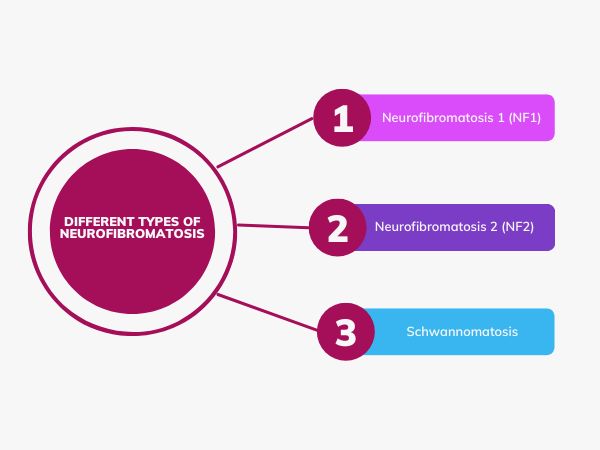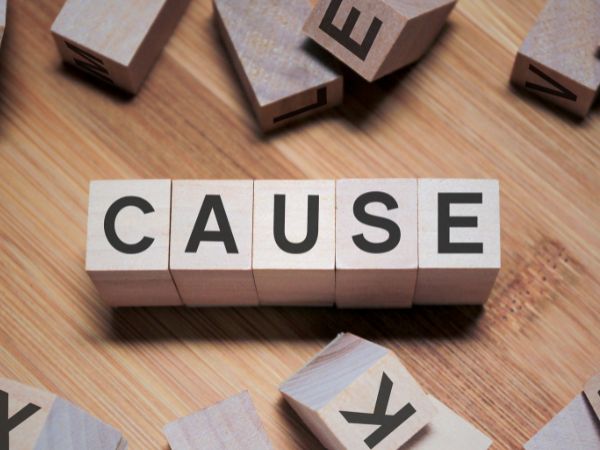Neurofibromatosis (NF) is a group of disorders that lead to the development of tumors, along types of nerves. These tumors have the potential to emerge anywhere in the body, including the brain, spinal cord, and nerves. Neurofibromatosis impacts several individuals worldwide. Can vary widely in terms of its severity and symptoms.
Different Types of Neurofibromatosis

There are three forms of neurofibromatosis:
- Neurofibromatosis Type 1 (NF1): NF1 is the prevalent type affecting roughly 1 in every 3,000 individuals around the world. It commonly manifests as café au lait spots ( brown birthmarks) freckling in skin folds and benign tumors known as neurofibromas.
- Neurofibromatosis Type 2 (NF2): NF2 is less common compared to NF1. Is characterized by the growth of tumors on nerves for hearing and balance. People with NF2 often develop schwannomas (tumors on nerves controlling balance and hearing).
- Schwannomatosis: Schwannomatosis represents the form of neurofibromatosis. It leads to the growth of schwannomas ( tumors), on cranial, spinal, and peripheral nerves. Unlike NF1 and NF2 schwannomatosis generally does not involve schwannomas.
Signs and Symptoms

The signs and symptoms of neurofibromatosis can vary depending on the type and severity of the condition. Some common symptoms may include;
- Neurofibromas: These are cancerous tumors that form either on or, under the skin.
- Café au lait spots: These are patches of coloration on the skin.
- Freckling: Spots with pigmentation are found typically in skin folds.
- Bone deformities: This can include conditions like scoliosis, bowed legs, or other abnormalities in structure.
- Vision problems: This may involve gliomas, which are tumors that grow on the optic nerve.
- Hearing loss: Particularly seen in individuals with NF2 due to vestibular schwannomas.
Please note that these symptoms can vary depending on cases and specific genetic factors.
Causes of Neurofibromatosis

Neurofibromatosis is caused by genetic mutations that affect the growth and regulation of nerve tissue. In most cases, the condition is inherited in an autosomal dominant pattern, meaning that a person only needs one copy of the mutated gene to develop the disorder. However, in about half of all cases, the condition occurs spontaneously due to new mutations in the gene.
Prevention of Neurofibromatosis
As neurofibromatosis is a genetic disorder, there are currently no known methods for preventing its occurrence. However, genetic counseling and testing can help individuals understand their risk of passing the condition to their children.
Treatment and Diagnosis

What treatment is available?
- There is no cure for NF.
- Neurofibromas that become large and painful can be cut out to reduce the risk of malignancy and other complications. The facial deformity can be mitigated by aesthetic (plastic) surgery.
- Genetic counseling and education about NF is important. One concern that should not be overlooked is the risk of isolation or loneliness in people with NF. People with NF are often anxious about future complications and sometimes disfiguring lesions can lead to withdrawal from society.
- Targeted molecular therapies show promise for the future treatment of neurofibromatosis.
Diagnosing neurofibromatosis typically involves a combination of clinical evaluation, medical history assessment, and genetic testing. Treatment options vary depending on the symptoms and severity of the condition. Some common treatment approaches include:
- Monitoring and surveillance: Regular check-ups to monitor the growth of tumors and assess any changes in symptoms.
- Surgical removal: For symptomatic neurofibromas or tumors that are causing complications.
- Medication: Certain medications may be prescribed to manage symptoms such as pain, seizures, or high blood pressure.
- Physical therapy: To address issues such as scoliosis or other skeletal abnormalities.
- Hearing aids or cochlear implants: For individuals with NF2 experiencing hearing loss.
Home Remedies for Neurofibromatosis

While there are no home remedies that can cure neurofibromatosis, individuals can take steps to manage symptoms and improve their overall well-being. These include:
- Regular exercise: Engaging in physical activity can help maintain flexibility, strength, and overall health.
- Healthy diet: Eating a balanced diet rich in fruits, vegetables, lean proteins, and whole grains can support overall health and immune function.
- Stress management: Practicing relaxation techniques such as meditation, yoga, or deep breathing exercises may help alleviate stress and improve quality of life.
- Support groups: Joining support groups or seeking counseling can provide emotional support and helpful coping strategies for individuals and families affected by neurofibromatosis.
Natural Supplements For Neurofibromas

The alkalinity of the body and the removal of toxins can reduce neurofibromas. Natural supplements such as bee propolis, aloe vera, curcumin, and colloidal-silver can reduce neurofibromas.
- Bee Propolis: Bee propolis is created by bees and has lots of anti-carcinogenic properties that reverse and stop the development of neurofibromas therefore, effective in treating neurofibromas. It also has properties that can boost your immune system as well.
- Aloe Vera: Aloe vera is an extract from the aloe plant. This aloe vera gel has immune system-boosting properties and it can also attack abnormal cells in the body and eliminate them from the body. (4)
- Curcumin: Curcumin is the active component of turmeric and has properties that can shrink and reduce the size of the neuromas even the larger ones. Therefore, it is beneficial for neurofibroma patients. (1)
- Colloidal-Silver: It has anti-toxin properties in it.
Conclusion
In conclusion, neurofibromatosis is a complex genetic disorder that requires ongoing management and support. While there is currently no cure, early diagnosis, regular monitoring, and appropriate treatment can help individuals with neurofibromatosis lead fulfilling lives and manage their symptoms effectively. Moreover, advances in medical research continue to shed light on the underlying causes of neurofibromatosis, offering hope for improved treatments and outcomes in the future.